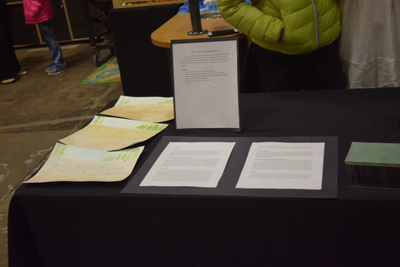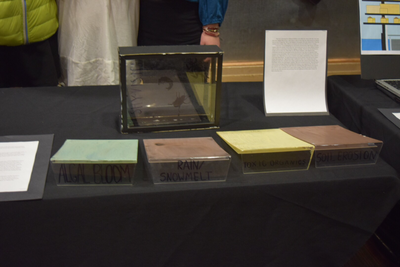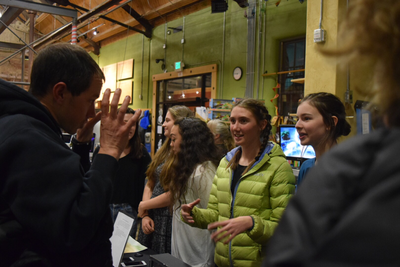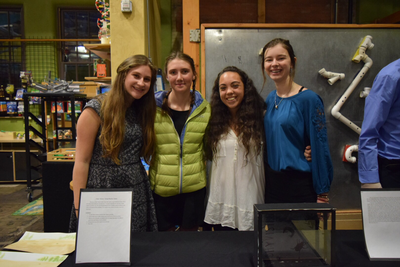Chemistry of food and cooking matzah crack
Cooking and science, while may seem very different, are actually quite similar. When science comes to mind often times it brings up the ideas of numbers, explosions, complicated ideas, and safety goggles, of course. Cooking brings up more thoughts of tasty food, ovens, and recipes. But the reality is, cooking is science. With science experiments, accuracy and measurements are key to coming up with the intended outcome, that is the same in cooking. Recipes contain the measurements, ratios, instructions needed to result in the completed dish. While doing science may seem more complicated, it is really just the same as following a recipe, maybe just with bigger words.
A difference between cooking and doing science is that cooking usually has more room for error is precision and accuracy. If you are baking a cake and want it a little sweeter or saltier, there is room to alter the ingredients and still result in your intended product. While doing science, accuracy is key in producing your intended outcome. If quantities of materials change, it can significantly alter the experiment.
Doing science often times means creating chemical reactions, which many times do not seem like typical occurrences in day to day life. In cooking, chemical reactions are everywhere. When making a scrambled egg, you might not think of the chemical reactions occuring. The egg is going from liquid to a solid, that is evidence of a chemical reaction. The heat being added to the egg is causing the reaction. Something as simple as cooking an egg may not seem like you are doing science, but it is.
While cooking ingredients are constantly being combined which when certain conditions are added, create chemical reactions. When cooking and mixing ingredients solids can liquify, liquids can solidify, temperature can change the forms, gases can be produced. All of these are chemical reactions. Even if it isn’t obvious, when cooking you are doing science.
A difference between cooking and doing science is that cooking usually has more room for error is precision and accuracy. If you are baking a cake and want it a little sweeter or saltier, there is room to alter the ingredients and still result in your intended product. While doing science, accuracy is key in producing your intended outcome. If quantities of materials change, it can significantly alter the experiment.
Doing science often times means creating chemical reactions, which many times do not seem like typical occurrences in day to day life. In cooking, chemical reactions are everywhere. When making a scrambled egg, you might not think of the chemical reactions occuring. The egg is going from liquid to a solid, that is evidence of a chemical reaction. The heat being added to the egg is causing the reaction. Something as simple as cooking an egg may not seem like you are doing science, but it is.
While cooking ingredients are constantly being combined which when certain conditions are added, create chemical reactions. When cooking and mixing ingredients solids can liquify, liquids can solidify, temperature can change the forms, gases can be produced. All of these are chemical reactions. Even if it isn’t obvious, when cooking you are doing science.
Your browser does not support viewing this document. Click here to download the document.
| Matzah Crack Recipe | |
| File Size: | 3288 kb |
| File Type: | docx |
Water Quality in the Animas river watershed
For me, this project turned the idea of turbidity and aquatic health from just terms to actual concepts. Prior to this project, the only real encounter with turbidity was when our grade went up to Silverton to test the water quality. When we were up there we used a machine to test the turbidity of the water. This water test was my only encounter with turbidity, and even then it was only just a number on a screen. As this project progressed I learned more and more about what turbidity was and how it affected the fish in our rivers. During a presentation on trout and aquatic life in our rivers, our guest speaker mentioned the fact the fish must see to eat and that they are indicator species. Fish mainly only reside in good quality water, so if your river is unclean there will be less of a fish presence in the waters. This is also true for when the fish cannot see their food. If the water is too dirty for a fish to see its prey, it will leave, indicating the poor water quality. This idea of the fish not being able to see stemmed the research for our prototype. We looked at different point and nonpoint source pollutants as well as how much they affect the turbidity of the water. From the conclusions, we drew about the turbidity from pollutants we created slides for our physical prototype. Another thing that I learned during this project was that not only does the turbid water affect the sight of the fish, but it also impacts their breathing. The sediment and substances in the turbid waters will get into the gills of the fish and make it difficult for them to breathe. This project truly expanded my understanding of what turbidity is and what it means for the fish in our water.
This project helped me learn new skills in Photoshop as well as help me learn to think on my feet when things go wrong. Often in my work at Animas, I use Photoshop. Whether it's in yearbook or humanities, I use it. This project helped me go beyond poster making and learn how to create something for three dimensional and intricate. I worked on three different turbidity slide images to create the scenes of the virtual reality game that we were prototyping. Sadly, I experienced an intense computer malfunction, which caused me to lose all of the work that I had done on the slides. After the computer malfunctioned, the day before the exhibition, I had to come up with something tangible to present alongside my group. I was able to sketch out scenes similar to what I had previously created and watercolor them, each showing a different turbidity level. I was able to think quickly to make up for the work that had been lost. During the exhibition I spoke to a constant stream of people, telling them my elevator pitch and explaining the two-part prototype we had designed. Even though my hard work on the Photoshop virtual reality didn’t pay off, I was able to think quickly and come up with a new presentation for my pieces.
I feel that water quality is definitely an important topic to study. In our current political climate, the environment is seemingly not peoples top priority. I feel that people push the idea of water quality back and ignore its problems. With global warming closing in fast, we are faced with a threat to the amount of water flowing in our streams from things such as snow runoff. When more natural water sources that contribute to our rivers are lessened, more sources such as mine drainage and agricultural runoff start to contaminate our waters. These pollutants affect people's drinking sources, fish habitats, and many other factors. Without people acknowledging water quality and all that it effects we negatively affect our environments and even ourselves.
This project helped me learn new skills in Photoshop as well as help me learn to think on my feet when things go wrong. Often in my work at Animas, I use Photoshop. Whether it's in yearbook or humanities, I use it. This project helped me go beyond poster making and learn how to create something for three dimensional and intricate. I worked on three different turbidity slide images to create the scenes of the virtual reality game that we were prototyping. Sadly, I experienced an intense computer malfunction, which caused me to lose all of the work that I had done on the slides. After the computer malfunctioned, the day before the exhibition, I had to come up with something tangible to present alongside my group. I was able to sketch out scenes similar to what I had previously created and watercolor them, each showing a different turbidity level. I was able to think quickly to make up for the work that had been lost. During the exhibition I spoke to a constant stream of people, telling them my elevator pitch and explaining the two-part prototype we had designed. Even though my hard work on the Photoshop virtual reality didn’t pay off, I was able to think quickly and come up with a new presentation for my pieces.
I feel that water quality is definitely an important topic to study. In our current political climate, the environment is seemingly not peoples top priority. I feel that people push the idea of water quality back and ignore its problems. With global warming closing in fast, we are faced with a threat to the amount of water flowing in our streams from things such as snow runoff. When more natural water sources that contribute to our rivers are lessened, more sources such as mine drainage and agricultural runoff start to contaminate our waters. These pollutants affect people's drinking sources, fish habitats, and many other factors. Without people acknowledging water quality and all that it effects we negatively affect our environments and even ourselves.
Fishy Vision Design Statment
Caeley, Amanda, Nyana, and Ava
Fishy Vision
Virtual Reality:
For the water quality educational exhibit at the water reclamation facility we have chosen to create an interactive virtual reality game of experiencing feeding habits of a fish in relation to water quality. In this virtual reality you will navigate through different turbidity levels, through the eyes of a fish, attempting to find food. This game will inform the audience of the issue of water quality and its effects on aquatic life.
I want the audience to leave with the following:
Curious:
The story my exhibit tells is:
The issue that our exhibit responds to is turbidity of our water. We want to inform people of the causes of change in turbidity and how that affects our river’s aquatic life. Our audience should feel engaged and connected to our exhibit because they are given the chance to be in the position of the fish. We started this work by
Fishy Vision
Virtual Reality:
For the water quality educational exhibit at the water reclamation facility we have chosen to create an interactive virtual reality game of experiencing feeding habits of a fish in relation to water quality. In this virtual reality you will navigate through different turbidity levels, through the eyes of a fish, attempting to find food. This game will inform the audience of the issue of water quality and its effects on aquatic life.
I want the audience to leave with the following:
- Lessons Learned:
- Importance of effects of water quality on aquatic life
- Using Fish and insects as indicator species of water quality
- Different pollution sources
- Turbidity and what that means for the quality of the water
- Feeling:
- Committed and engaged
Curious:
- About how they can help
- Durango’s water quality
- Durango’s indicator species
- Are you contributing to the water pollution?
- Are you part of the issue?
The story my exhibit tells is:
The issue that our exhibit responds to is turbidity of our water. We want to inform people of the causes of change in turbidity and how that affects our river’s aquatic life. Our audience should feel engaged and connected to our exhibit because they are given the chance to be in the position of the fish. We started this work by
Fishy Vision: Virtual Reality Game
Welcome to Fishy Vision! In this virtual reality game you get to become a hungry fish in the Animas River looking for your next meal. You must navigate the river and catch as many insects as possible. You will swim through different levels of turbidity caused by different point source and nonpoint source pollutants. Try to catch as many insects as possible to stay alive! Good luck!
Guidelines:
Fishy Vision: Interactive Slides
This box is showing how different turbidity levels affect the vision of the fish, who must see to eat. Imagine that you are a fish trying to catch its food when the water around you darkens and you can no longer see. This is what happens to the aquatic life in the Animas River when the turbidity levels change. Many different occurrences can cause the turbidity levels to change.
In this box, we are highlighting how soil erosion, rain/snowmelt, algal blooms, and toxic organics affect the turbidity levels in the river. Soil erosion can occur for many different reasons, such as if there is construction, forest fires, logging, or mining. Roots by the river hold the soil in place and out of the river. When there is a fire, flood, windstorm, other natural events, construction near the river, and human activity near the river it may take out vegetation which increases erosion and turbidity. Rain and snowmelt increase runoff which generally increases the turbidity level. When there is an excess of nutrients and a higher concentration of these nutrients it can cause algal blooms. The algal blooms become food for bacteria which take up the oxygen, killing other aquatic life. Algal blooms make it difficult for fish to thrive because they aren’t getting the oxygen they need and it also creates a green scum that is hard to swim through. Fish need plants, insects, and small aquatic creatures. They serve as food for the fish. When pollutants such as erosion and algal blooms kill off these food sources, it can negatively affect the fish. Do you remember the Gold King Mine spill? Well, the Gold King Mine spill released toxic organics into our river which caused the river to turn a yellow-orange. When this occurred the turbidity level rose and while the toxins did not kill any fish, the heightened turbidity made it harder for fish to find their food.
Welcome to Fishy Vision! In this virtual reality game you get to become a hungry fish in the Animas River looking for your next meal. You must navigate the river and catch as many insects as possible. You will swim through different levels of turbidity caused by different point source and nonpoint source pollutants. Try to catch as many insects as possible to stay alive! Good luck!
Guidelines:
- You have three minutes to catch as many insects as possible
- Catch enough insects in three minutes and you will survive, if not you will die
- While you are in the game, the turbidity level will change depending on the effect of point source and nonpoint source pollutants
- Navigate the Animas River and its twists and turns
- Have Fun!
Fishy Vision: Interactive Slides
This box is showing how different turbidity levels affect the vision of the fish, who must see to eat. Imagine that you are a fish trying to catch its food when the water around you darkens and you can no longer see. This is what happens to the aquatic life in the Animas River when the turbidity levels change. Many different occurrences can cause the turbidity levels to change.
In this box, we are highlighting how soil erosion, rain/snowmelt, algal blooms, and toxic organics affect the turbidity levels in the river. Soil erosion can occur for many different reasons, such as if there is construction, forest fires, logging, or mining. Roots by the river hold the soil in place and out of the river. When there is a fire, flood, windstorm, other natural events, construction near the river, and human activity near the river it may take out vegetation which increases erosion and turbidity. Rain and snowmelt increase runoff which generally increases the turbidity level. When there is an excess of nutrients and a higher concentration of these nutrients it can cause algal blooms. The algal blooms become food for bacteria which take up the oxygen, killing other aquatic life. Algal blooms make it difficult for fish to thrive because they aren’t getting the oxygen they need and it also creates a green scum that is hard to swim through. Fish need plants, insects, and small aquatic creatures. They serve as food for the fish. When pollutants such as erosion and algal blooms kill off these food sources, it can negatively affect the fish. Do you remember the Gold King Mine spill? Well, the Gold King Mine spill released toxic organics into our river which caused the river to turn a yellow-orange. When this occurred the turbidity level rose and while the toxins did not kill any fish, the heightened turbidity made it harder for fish to find their food.




